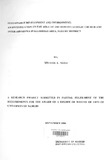| dc.description.abstract | The aim of this study is to highlight the relationship between the environment and sustainable
development in Kiambogo area. This was meant to bridge the academic gap created by the
previous studies in the same field that have inclined much to the causes and effects of
environmental degradation, with little emphasis on the linkages between environment and
sustainable development, especially where the church and NGOs are involved.
Findings for this study have been collected from both primary as well as secondary sources.
Primary sources included questionnaires, interviews and observation methods. Secondary
sources that form part of the bibliography were collected from library materials such as books,
journals, Internet, reports, archives and periodicals.
This study explores the role played by the Roman Catholic Church and Inter Aid Kenya (NGO)
in environmental rehabilitation in Kiambogo area. Their participation in development activities
in this area has been seen to reflect and bring out the relationship between environment and
sustainable development. it was also the objective of this study to investigate the causes and
impact of environmental degradation in Kiambogo area and the role of Kiambogo community in
conserving their immediate environment.
This study has shown that, environmental de-gradation in Kiambogo area is caused by human settlement, wild fires, lack of proper forest management, poor farming methods, laxity by law
enforcers, over population and above all poverty. The effect of this degradation have been poor
agricultural harvest, lack of water, adverse climatical changes and gross abject poverty.
These causes and effects of environmental degradation in Kiambogo area have revealed that,
there is dialectical relationship between sustainable development and environment. Environment
degradation increases poverty and poverty prevalence is the main cause of environmental
degradation especially to the communities that heavily depend on their immediate environment
for survival. 'Creative awareness' environmental education and agriculture have also been seen
as part of this dialectical relationship.
The study suggests a number of ways that would facilitate sustainable development In
communities whose way of life directly depend on environment.
First, the study has revealed that it is very difficult to establish a sustained environmental
programme in poor communities who depend on their immediate environment for survival.
Therefore, there is need to explore alternative sources of income and sources of energy to these
communities so as to reduce the pressure exacted by these communities on their immediate
environment in their effort to salvage a living. This includes possibilities of entrepreneurship,
poultry farming, agro forestry, eco and cultural tourism. There is also need to explore use solar
energy and biogas.
Secondly, churches and religious groups in the region should embark on what Obeng call
'creative awareness' environmental campaign. This will demand theologians in the area to
sensitise the locals on the religious duties of mankind towards God created world. This would
include emphasising that Kiambogo residents have a moral responsibility to care and protect
their immediate environment. The campaign should be action oriented. It should bring on board,
Government agencies, NGOs and CBOs, through a comprehensive environmental programmes
that would put more stress on reforestation, af-orestation, agro forestry and land reclamation. This
way, communities will be able to salvage their destryed environment as well as conserve the
existing one.
Thirdly, Government agencies, NGOs and other environment stakeholders should apply
community participatory methods in their development and environmental initiatives. This
means incorporating community based organizations that are constituted by the local members
and have first hand information on the problem affecting them. Bringing the community intended
to be the beneficiary of the project on board would be very effective since the community would
feel as being part and parcel of the solution to the problems affecting them. This project has
identified the Small Christian community as a very viable target for this venture. They are
religious based and constituted by local residents with a mission to empower members
spiritually, physically and socially.
Fourth, the government should set aside a percentage of C.D.F (Constituency Development
Fund), in every constituency for environmental conservation programme. This can be achieved
by making this fund available to C.B.O.s and women groups on the ground for tree planting and
other environmental rehabilitation programmes.
In nutshell, the study showed that, poverty prevalence cannot be fought effectively without a
sustained environment. On the other hand, effective environmental programme can only be
achieved where poverty prevalence is low. Therefore, poverty and environmental degradation are
intertwined. | en |

